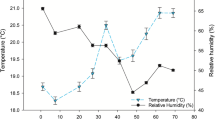Abstract
Greenhouse nutrient solution studies demonstrated that diniconazole will decrease peanut (Arachis hypogaea L.) shoot growth when either root or shoot applied. Root growth and development were decreased by root and, to a lesser extent, by shoot uptake of diniconazole. Diniconazole is apparently xylem translocated, but not phloem translocated. Concentrations of 200 ppb ES isomer of diniconazole in nutrient solution (root uptake) increased specific leaf weight and starch deposits in the leaf. Field applications of 193 g ES isomer ha−1 of diniconazole reduced main stem height by 33%, leaf area index by 16%, and total vegetative dry weight by 19%, but had no effect on average leaf size. Decreased germination of seeds from plants treated with 1435 g ha−1 diaminozide was associated with increased seed dormancy. Seed dormancy was counteracted by either ethylene gas or storage for 150 days after harvest. Soil applications of diniconazole were more effective than foliar appliations in reducing vine growth. Diniconazole's ER isomer is a broad spectrum fungicide that reduced damage (when compared to the control) bySclerotium rolfsii andRhizoctonia solani. The reduced damage by these diseases was thought to be the primary reason for the significant pod yield increase (when compared to the control) observed with the diniconazole treatments. In drought-stressed plots, populations of the two-spotted spider mite (Tetranychus urticae) were increased by diniconazole.
Similar content being viewed by others
References
Barrett JE, Bartuska CA (1982) PP333 effects on stem elongation dependant on site of application. HortScience 17:737–738
Bausher MG, Yelonsky G (1987) Morphological changes inCitrus associated with relatively high concentrations of paclobutrazol. J Plant Growth Regul 5:139–147
Campbell WB (1978) Interactions of pesticides and two spotted spider mites on peanuts. Am Peanut Research and Education Soc Proc 10:59
Funaki Y, Ishiguri Y, Kato T, Tanaka S (1983) Structure-activity relationships of a new fungicide S-3308 and its derivatives. In: Miyamoto J, Kearney PC (eds) Pesticide chemistry: human welfare and the environment. Proceedings of the 5th internatinal congress of pesticide chemistry, Kyoto, Japan, 29 Aug–4 Sept 1982. Pergamon, London, pp 309–314
Hoehne FC (1940) Leguminosas-papilionadas generoArachis. In: Hoehne FC (ed) Flora Brasilica. Romiti and Lanzara, Sao Paulo Brazil 25(II), 122:1–20
Ketring DL, Morgan PW (1972) Physiology of oil seeds. IV. Role of endogenous ethylene and inhibitory regulations during natural and induced after-ripening of dormant Virginia-type peanut seeds. Plant Physiol 50:382–387
Koller W (1987) Isomers of sterol synthesis inhibitors: Fungicidal effects and plant growth regulator activities. Pestic Sci 18:129–147
Moore TC (1968) Translocation of the growth retardant N,N-dimethylamino-succinamic acid-14C (B-995-14C). Bot Gaz 129:280–285
Raese JT, Burts EC (1983) Increased yield and suppression of shoot growth and mite populations of ‘D'Anjou’ pear trees with nitrogen and paclobutrazol. HortScience 18:212–214
Rodriguez-Kabana R, Backman PA, Williams JC (1975) Determination of yield losses toSclerotium rolfsii in peanut fields. Plant Dis Rep 49:855–858
Rothenberger RR (1964) Studies of translocation, metabolism and environmental responses of ornamental plants to chemical growth retardants. PhD dissertation, University of Missouri, Columbia, MO
SAS Institute (1984) SAS user's guide: Statistics, 1982 edn. SAS Institute, Cary, NC
Sponsel VM (1986) Gibberellins in the pea plant. Plant Growth Regul Soc Am Bull 14:6–8
Steffens GL, Wang SY, Steffens CL, Brennant T (1983) Influence of paclobutrazol (PP333) on apple seedling growth and physiology. Proc Plant Growth Regul Soc Am 10:195–206
Wieland WF, Wample RL (1984) Effects of paclobutrazol on shoot growth, photosynthesis, and root growth in apple. HortScience 19:529
Wilfret GJ (1981) Height retardation of poinsettia with ICI PP333. Hortic Sci 16:443
Williams EJ, Drexler JS (1981) A non-destructive method for determining peanut pod maturity. Peanut Sci 8:134–141
Williams MW, Curry EA, Visser DB (1984) Methods of application of paclobutrazol on deciduous fruit trees. HortScience 19:577
Womack H, French JC, Johnson FA, Thompson SS, Swan CW (1981) Peanut pest management in the southeast. Coop Ext Ser Univ Ga Bull no. 850
Author information
Authors and Affiliations
Additional information
Mention of a trademark, proprietary product, or vendor does not constitute a guarantee by the University of Georgia or the U.S. Department of Agriculture and does not imply UGA or USDA approval to the exclusion of other products or vendors that also may be suitable.
Rights and permissions
About this article
Cite this article
Kvien, C.S., Csinos, A.S., Ross, L.F. et al. Diniconazole's effect on peanut (Arachis hypogaea L.) growth and development. J Plant Growth Regul 6, 233–244 (1987). https://doi.org/10.1007/BF02102552
Received:
Accepted:
Issue Date:
DOI: https://doi.org/10.1007/BF02102552




